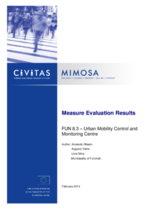Urban mobility control and monitoring centre
Thematic areas
Smart, Sustainable, Connected and Shared mobility
- ITS-based enhancement of public transport
Summary
The measure ´Urban Mobility Control and Monitoring Center´ aimed to establish a MobilityObservatory as a tool for monitoring and managing mobility issues in Funchal. Theobservatory has as main goal to support the Municipality with a tool that can backup a betterarticulation.
Implementing sustainable mobility
Funchal developed an urban mobility control and monitoring centre that will be the first integrated system of its kind in Madeira and that have the capacity to process and disseminate data on the mobility system. Reliable data and mobility simulations can be used to support local politicians and technicians in the decision-making process.
The main objectives of the measure were to:
• Improve knowledge about both the transport network and mobility;
• Create an information centre that allows the promotion and consolidation of an innovative sustainable mobility culture while fostering the current mobility pattern towards a better life quality among the population;
• Provide easy and efficient access to all pertinent information that could allow a better management of all issues related with urban mobility;
• Contribute towards a better execution in decision making and mobility actions;
• Establish mobility partnerships with all entities that deal (in)directly with traffic related issues;
• Manage an information database and its sources that aren´t currently being shared by several entities;
• Monitor the development and evolution of mobility and transport system;
• Promote the integration between both the mobility component and the territorial planning component;
• Implementation of a platform in which all entities can share and disseminate data;
• Serve as an information and communication tool for the general public;
• Promote a more sustainable mobility, and consequently, improve quality of life in the city.
The observatory also relies on the mobility pacts that are understood as an instrument in which the Municipality and other actors in the field of mobility set, voluntarily and collectively, the guiding principles for its operations in order to contribute to a more sustainable mobility strategy, reflected in the development of actions and measures that each undertakes.
Progress
The implementation of the measure was structured in three main fields of activities:
Development activities (October 2009 – September 2012) - During the earliest stage of the measure stakeholders involved in the Mobility Observatory were identified and efforts were given to establish joint partnerships. At the same time, the structure of the concept was designed. Information on every mode of transport used in Funchal (individual and collective) collected for the establishment of the transport network in 2007, was updated. This information aims at feeding the modelation software (VISUM and VISSIM) that was acquired in this measure.
Mobility pacts (June 2011 - September 2012) - By signing the Mobility pacts, the Municipality and the relevant partners in the field of mobility agreed to work in close collaboration and to follow the guiding principles formulated in the pacts which defined the operation of the Observatory in order to contribute to a more sustainable mobility strategy.
Sofware acquisition and training (March 2009 - June 2012) - Modelling software for traffic planning were purchased by the municipality and traffic planners were trained to use efficiently the software and manage the Observatory.
The success of the observatory relies on establishing protocols and collecting data. The future goals will be to further establish protocols with other entities and increase the number of indicators available on the database. In addition to the necessity of updating data continuously, the need to create new indicators implies the existence of a small support team.
Outcomes
To support the observatory, 80 indicators were defined and arranged according to a vast array of group themes, such as population and territory, logistics, public transport, parking, soft modes, mobility, environment and road safety. Currently, the platform holds 29 indicators.
According to surveys conducted, the majority of the respondents considers the observatory useful (84,1% in 2010 and 82,4% in 2011). Moreover, the interviews showed that all respondents consider the observatory as an important contribution to the knowledge of the mobility dynamics in Funchal and a good instrument in supporting decision policy. The respondents also considered it important that all data should be updated regularly.








